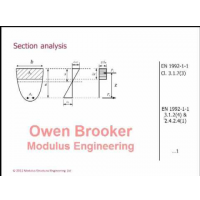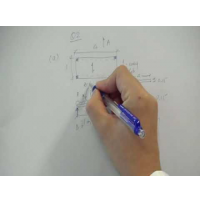Reinforcing steel
Table lists the characteristic design strengths of some of the more common types of reinforcement currently used in the UK. Grade 500 (500N/mm2 characteristic strength) has replaced Grade 250 and Grade 460 reinforcing steel throughout Europe. The nominal size of a bar is the diameter of an equivalent circular area.
| Designation | Normal size (mm) | Specified characteristic strength fyk (N/mm2) |
| Hot-rolled high yield |
All sizes |
500 |
| Cold-worked high yield |
Up to and including 12 |
500 |
Grade 250 bars are hot-rolled mild-steel bars which usually have a smooth surface so that the bond with the concrete is by adhesion only. This type of bar can be more readily bent, so they have in the past been used where small radius bends are necessary, such as links in narrow beams or columns, but plain bars are not now recognised in the European Union and they are no longer available for general use in the UK.
High-yield bars are manufactured with a ribbed surface or in the form of a twisted square. Square twisted bars have inferior bond characteristics and have been used in the past, alrough they are now obsolete. Deformed bars have a mechanical bond with the concrete. The bending of high-yield bars through a small radius is liable to cause tension cracking of the steel, and to avoid this the radius of the bend should not be less than two times the nominal bar size for small bars (≤ 16 mm) or 3½ times for larger bars. The ductility of reinforcing steel is also classified for design purposes. Ribbed high yield bars may be classified as:
Class A – which is normally associated with small diameter (≤ 12 mm) cold-worked bars used in mesh and fabric. This is the lowest ductility category and will include limits on moment redistribution, which can be applied and higher quantities for fire resistance.
Class B -which is most commonly used for reinforcing bars.
Class C – high ductility which may be used in earthquake design or similar situations.
Floor slabs, walls, shells and roads may be reinforced with a welded fabric of reinforcement, supplied in rolls and having a square or rectangular mesh. This can give large economies in the detailing of the reinforcement and also in site labour costs of handling and fixing. Prefabricated reinforcement bar assemblies ere also becoming increasingly popular for similar reasons. Welded fabric mesh made of ribbed wire greater than 6 mm diameter may be of any of the ductility classes listed above.
The cross-sectional areas and perimeters of various sizes of bars, and the cross-sectional area per unit width of slabs are listed in the Appendix. Reinforcing bars in a member should either be straight or bent to standard shapes. These shapes must be fully dimensioned and listed in a schedule of the reinforcement which is used on site for the bending and fixing of the bars. Standard bar shapes and a method of scheduling are specified in BS8666. The bar types as previously described are commonly identified by the following codes: H for high yield steel, irrespective of ductility class or HA, HB, HC where a specific ductility class is required.

